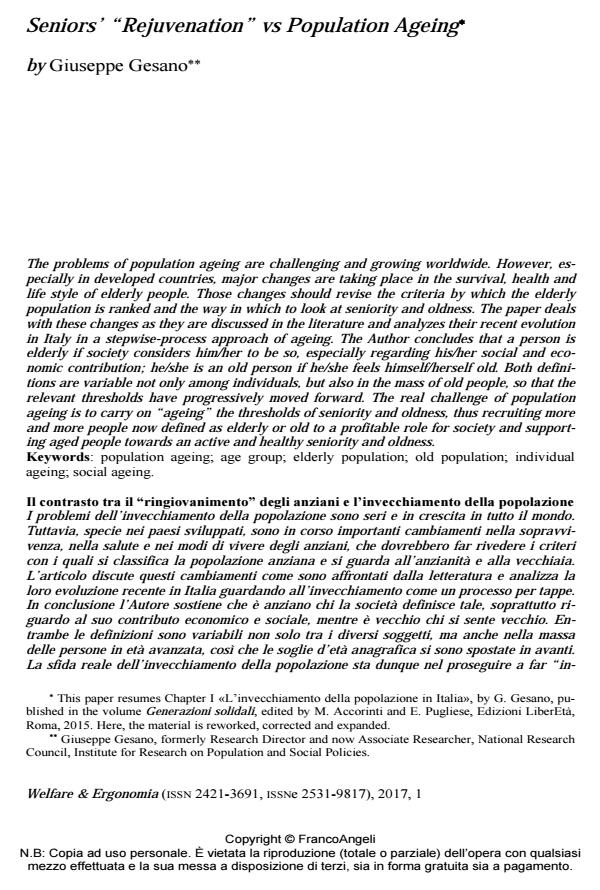Seniors’ "Rejuvenation" vs Population Ageing
Journal title WELFARE E ERGONOMIA
Author/s Giuseppe Gesano
Publishing Year 2018 Issue 2017/1
Language English Pages 16 P. 47-62 File size 240 KB
DOI 10.3280/WE2017-001003
DOI is like a bar code for intellectual property: to have more infomation
click here
Below, you can see the article first page
If you want to buy this article in PDF format, you can do it, following the instructions to buy download credits

FrancoAngeli is member of Publishers International Linking Association, Inc (PILA), a not-for-profit association which run the CrossRef service enabling links to and from online scholarly content.
The problems of population ageing are challenging and growing worldwide. However, es-pecially in developed countries, major changes are taking place in the survival, health and life style of elderly people. Those changes should revise the criteria by which the elderly population is ranked and the way in which to look at seniority and oldness. The paper deals with these changes as they are discussed in the literature and analyzes their recent evolution in Italy in a stepwise-process approach of ageing. The Author concludes that a person is elderly if society considers him/her to be so, especially regarding his/her social and economic contribution; he/she is an old person if he/she feels himself/herself old. Both definitions are variable not only among individuals, but also in the mass of old people, so that the relevant thresholds have progressively moved forward. The real challenge of population ageing is to carry on "ageing" the thresholds of seniority and oldness, thus recruiting more and more people now defined as elderly or old to a profitable role for society and supporting aged people towards an active and healthy seniority and oldness.
Keywords: Population ageing; age group; elderly population; old population; individual ageing; social ageing.
- Arendt H. (1961). Between past and Future. Eight Exercises in Political Thought. London – New York: Penguin Books, 1968.
- Bailey S.J., Letiecq B.L. and Porterfield F. (2009). Family Coping and Adaptation Among Grandparents Rearing Grandchildren. Journal of Intergenerational Relationships, 7(2-3): 144-158. DOI: 10.1080/15350770902851072
- Chudacoff H.P. and Hareven T.K. (1979). From the Empty Nest to Family Dissolution: Life Course Transitions into Old Age. Journal of Family History, 4(1): 69-83. DOI: 10.1177/036319907900400105
- Clarke L. and Roberts C. (2004). The meaning of grandparenthood and its contribution to the quality of life of older people. In: Walker A. and Hennessy C.A., editors. Quality of life in old age. Maidenhead, Berkshire (UK): Open University Press.
- Demuru E. and Egidi V. (in print). Adjusting prospective age for health status: how to rejuvenate the population by improving health.
- Dennerstein L., Dudley E. and Guthrie J. (2002). Empty nest or revolving door? A prospective study of women’s quality of life in midlife during the phase of children leaving and reentering the home. Psychological Medicine, 32(3): 545-550. DOI: 10.1017/S0033291701004810
- Dowd J.J. (1975). Aging as Exchange: A Preface to Theory. Journal of Gerontology, 30(5): 584-594.
- Hansson R.O. and Remondet J.H. (1988). Old Age and Widowhood: Issues of Personal Control and Independence. Social Issues, 44(3): 159-174.
- Human Mortality Database. University of California, Berkeley (USA), and Max Planck Institute for Demographic Research (Germany). Available at: http://www.mortality.org or http://www.humanmortality.de, data downloaded on Sept. 7, 2017.
- INPS (2017). XVI Rapporto Annuale. Available at: https://www.inps.it/nuovoportaleinps/default.aspx?sPathID=%3b0%3b46396%3b50544%3b&lastMenu=50544&iMenu=12&iNodo=50544&p4=2, accessed on Aug. 2, 2017.
- ISTAT (2014). La salute e il ricorso ai servizi sanitari. Available at: http://www.istat.it/it/archivio/144093, accessed on 8/8/2017.
- ISTAT (2016). Rapporto annuale 2016 – La situazione del Paese. Roma: ISTAT.
- Jacini S. (1885). Relazione finale sui risultati dell’Inchiesta Agraria e sulle condizioni della classe agricola. Atti della Giunta, Vol. XV. Roma: Forzani e C. Tipografi del Senato.
- Kafka F. (1920). He – Aphorisms from the 1920 diary: 17 January. In: Kafka F., The Great Wall of China, And Other Short Works. Translated from the German and edited by Malcolm Pasley. London – New York: Penguin Classics, 2002.
- Knapp R.J. and Capel W.C. (1979). Introduction. Journal of Drug Issues, 9(1): 1-3. DOI: 10.1177/002204267900900101
- Lavretsky H. and Irwin M.R. (2007). Resilience and aging. Aging Health, 3(3). DOI: 10.2217/1745509X.3.3.309
- Lutz W., Sanderson W. and Scherbov S. (2008). The coming acceleration of global population ageing. Nature, 451: 716-719.
- Mitnitski A. and Rockwood K. (2015). Aging as a Process of Deficit Accumulation: Its Utility and Origin. In: Yashin A.I. and Jazwinski S.M., editors. Aging and Health – A Systems Biology Perspective. Interdisciplinary Top Gerontology. Basel: Karger, 2015, 40: 85-98. DOI: 10.1159/000364933
- Palmore E., Cleveland W.P., Nowlin J.B., Ramm D. and Siegler I.C. (1979). Stress and Adaptation in Later Life. Journal of Gerontology, 34(6): 841-851.
- Ryder N. (1975). Notes on Stationary Populations. Population Index, 41(1): 3-28. DOI: 10.2307/2734140
- Sanderson W.C. and Scherbov S. (2005). Average Remaining Lifetimes Can Increase as Human Populations Age. Nature, 435: 811-813.
- Sanderson W.C. and Scherbov S. (2007). A new perspective on population aging. Demographic Research, vol. 16, art. 2: 27-58.
- Sanderson W.C. and Scherbov S. (2008). Rethinking Age and Aging. Population Bulletin, 63(4).
- Suzman R.M. and Riley M.W. (1985). Introducing the “Oldest Old”. The Milbank Memorial Fund Quarterly. Health and Society. Vol. 63, No. 2, Special Issue: The Oldest Old (Spring, 1985): 175-186. DOI: 10.2307/3349879
- Suzman R.M., Willis D.P. and Manton K.G. (1992). Introducing the oldest old. In: Suzman R.M., Willis D.P. and Manton K.G., editors. The Oldest Old. New York – Oxford: Ox-ford University Press.
- UN – United Nations, Department of Economic and Social Affairs, Population Division (2017). World Population Prospects – The 2017 Revision – Key Findings and Advance Tables. ESA/P/WP/248. New York: United Nations. Available at: https://esa.un.org/unpd/wpp/Publications/Files/WPP2017_KeyFindings.pdf.
- WHO – World Health Organization (2015). World Report on Ageing and Health. Luxembourg: WHO.
Giuseppe Gesano, Seniors’ "Rejuvenation" vs Population Ageing in "WELFARE E ERGONOMIA" 1/2017, pp 47-62, DOI: 10.3280/WE2017-001003